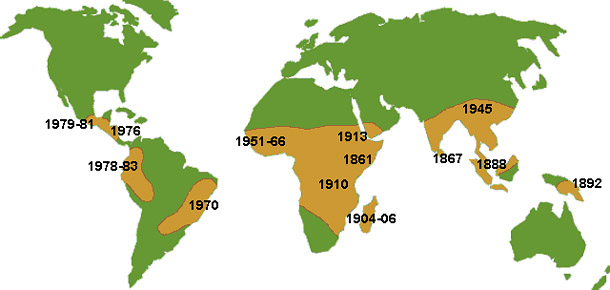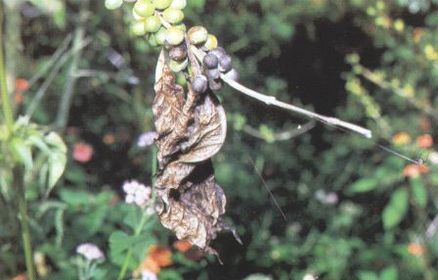Team:Colombia/Project/Problem
From 2012.igem.org
(→Coffee patogens) |
(→Coffee patogens) |
||
| Line 29: | Line 29: | ||
<br> | <br> | ||
<br> | <br> | ||
| + | |||
| + | |||
| + | |||
| + | |||
| + | |||
| + | |||
| + | |||
| + | |||
| + | |||
| + | |||
| + | |||
| + | |||
| + | |||
Revision as of 18:02, 24 September 2012
Template:Https://2012.igem.org/User:Tabima
Contents |
The Problem
Bacterial Wilt (Ralstonia solanacearum)
Ralstonia solanacearum attack almost 200 plant species in 33 different plant families. This constitutes one of the largest known host ranges for any plant pathogenic bacterium (Moorman BM., 2012). The disease it causes is known as Southern wilt, bacterial wilt, and brown rot of potato. Although Solanaceae (potato family) contains the greatest number of susceptible species, many other dicot and a few monocot plants are also susceptible. The important agricultural crops attack by this phytopathogen includes: Potato (Solanum tuberosum); Tomato (Lycopersicum esculentum); Aubergine (egg plant) (Solanum melongena); Banana, (Musa spp); Geranium (common name) (Pelargonium); Ginger (Zingiber officinale); Tobacco (Nicotiana tabacum); Sweet pepper (Capsicum spp); Olive (Olea europea) (USDA,2011). According to the USDA is considered an invasive organism and as there are no chemicals or biological agents that adequately control these bacteria. Infected plants MUST be discarded as soon as possible (Moorman B.M.,2012).
Coffee patogens
Coffee is the most important agricultural product in international trade. Even a small reduction in coffee yields or a modest increase in production costs caused by the rust has a huge impact on the coffee producers, the support services, and even the banking systems in those countries whose economies are absolutely dependent on coffee export (Arneson, 2000).
Coffe rust
Coffee rust is the most economically important coffee disease in the world, and in monetary value. This fungus Hemileia vastatrix belongs to the class Basidiomycetes, the order Uredinales, and family Pucciniaceae. Even though it is capable of producing urediniospores and basidiospores, only the former infect the coffee plant while the latter have no known susceptible host. Urediniospores infect usually during rainy seasons, since germination requires a 24 to 48 hour continuous presence of free water (rain or heavy dew). Infection occurs over a wide range of temperature: from 15°C to 28°C with an optimum of 22°C, and only occurs through stomata on the underside of the leaf, so it does not form the pustules typical of many rusts. The infected leaves drop prematurely, which reduces photosynthetic capacity and weakens the plant (as seen in the following pictures), altogether reducing next season’s berry yield (as much as 10-fold) (Arneson, 2000).
Other pests:
The rust is not the only plague. Talking with coffee growers, they told us that there are new plagues that attack the coffee plants and even the resistant strains are attacked. A major problem is the "Pink disease". This fungus "Costicium salmonicolor"belongs to the class Basidiomycetes and according to the coffee growers is a disease that have been affecting the production in most parts of the country.
References
- Arneson, P. A. (2000). Coffee rust. The Plant Health Instructor. doi:10.1094/PHI-I-2000-0718-02
- USDA (2011) National Agricultural Library. Research; Special Note: NAL Catalog Search
- Moorman B.M. (2012) Bacterial wilt-Ralstonia solanacearum. Penn State Extension: Plant disease fact sheets. Available on line at: http://extension.psu.edu/plant-disease-factsheets/all-fact-sheets/ralstonia
 "
"


